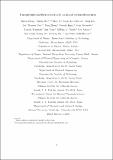Unconventional ferroelectricity in moiré heterostructures
Author(s)
Zheng, Zhiren; Ma, Qiong; Bi, Zhen; de la Barrera, Sergio; Liu, Ming-Hao; Mao, Nannan; Zhang, Yang; Kiper, Natasha; Watanabe, Kenji; Taniguchi, Takashi; Kong, Jing; Tisdale, William A.; Ashoori, Raymond; Gedik, Nuh; Fu, Liang; Xu, Suyang; Jarillo-Herrero, Pablo; ... Show more Show less
DownloadBLG_moireFE_maintext_figures.pdf (3.536Mb)
Publisher Policy
Publisher Policy
Article is made available in accordance with the publisher's policy and may be subject to US copyright law. Please refer to the publisher's site for terms of use.
Terms of use
Metadata
Show full item recordAbstract
The constituent particles of matter can arrange themselves in various ways, giving rise to emergent phenomena that can be surprisingly rich and often cannot be understood by studying only the individual constituents. Discovering and understanding the emergence of such phenomena in quantum materials—especially those in which multiple degrees of freedom or energy scales are delicately balanced—is of fundamental interest to condensed-matter research. Here we report on the surprising observation of emergent ferroelectricity in graphene-based moiré heterostructures. Ferroelectric materials show electrically switchable electric dipoles, which are usually formed by spatial separation between the average centres of positive and negative charge within the unit cell. On this basis, it is difficult to imagine graphene—a material composed of only carbon atoms—exhibiting ferroelectricity3. However, in this work we realize switchable ferroelectricity in Bernal-stacked bilayer graphene sandwiched between two hexagonal boron nitride layers. By introducing a moiré superlattice potential (via aligning bilayer graphene with the top and/or bottom boron nitride crystals), we observe prominent and robust hysteretic behaviour of the graphene resistance with an externally applied out-of-plane displacement field. Our systematic transport measurements reveal a rich and striking response as a function of displacement field and electron filling, and beyond the framework of conventional ferroelectrics. We further directly probe the ferroelectric polarization through a non-local monolayer graphene sensor. Our results suggest an unconventional, odd-parity electronic ordering in the bilayer graphene/boron nitride moiré system. This emergent moiré ferroelectricity may enable ultrafast, programmable and atomically thin carbon-based memory devices.
Date issued
2020-11Department
Massachusetts Institute of Technology. Department of Physics; Massachusetts Institute of Technology. Department of Electrical Engineering and Computer Science; Massachusetts Institute of Technology. Department of Chemical Engineering; Massachusetts Institute of Technology. Materials Research LaboratoryJournal
Nature
Publisher
Springer Science and Business Media LLC
Citation
Zheng, Zhiren et al. "Unconventional ferroelectricity in moiré heterostructures." Nature 588, 7836 (November 2020): 71–76 © 2020 The Author(s)
Version: Author's final manuscript
ISSN
0028-0836
1476-4687